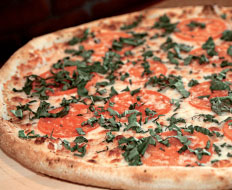In a world of novel-length menus and menuboards that fill entire walls, Flippin’ Pizza stands out for the simplicity of its offerings. Customers choose their sauce preference: white or red. There’s only one crust option, and whole pies come in an 18-inch size only. Pizza can be ordered by the slice, and the adventurous eater can get a calzone or a salad. But that’s the extent of it. And that’s the way founder Patrick Farley likes it.
“I believe you should concentrate on what you do well,” he says. “We have a simple menu. We don’t do lasagna because everybody’s mom or grandma can do that. But how many grandmas make hand-tossed pizza?” That hand-tossed component gives the brand its name and is a skill, Farley says, that “some people are more adept at than others.”
“It takes a couple of months to learn how to spin and flip the dough to make good, consistent pies,” he says.
While Flippin’ Pizza got its start in Southern California, it serves New York–style pizza. “What I found living out here is that a lot of places claim to have New York–style pizza just because they have a thin crust, but there is so much more to it than that,” says Farley, a New York native.
One component of authentic New York–style pizza is the water used in the crust, which must have the same chemical makeup as New York water, Farley says.
“We use a reverse-osmosis system to replicate the pH balance of New York water,” Farley says. “It removes the chlorine and the hard minerals we don’t want, but leaves the minerals we do want.”
No oil or sugar is added to the Flippin’ Pizza dough, which he says results in an airy, clean-tasting, crispy crust. Pizzas are cooked on a stone that’s heated to more than 600 F.
Flippin’ Pizza
Founder & President: Patrick Farley
HQ: San Diego
Year Started: 2007
Annual Sales: Undisclosed
Total Units: 17
Franchise units: 13
“We don’t compromise in any area,” Farley says. “We use a high-quality, whole-milk cheese, for example. We make our own recipe sauces at a commissary, but the dough you have to make in the store.”
At a typical Flippin’ Pizza location, dine-in orders account for 50 percent of sales and the remaining sales are split between takeout and delivery orders. About 60 percent of pizza sales are whole pies and 40 percent are slices. Selling pizza by the slice can be a challenge, though.
“We have to know how many we will sell on a daily basis,” Farley says. “We don’t hold anything more than two hours. You have to know your demand. But it’s like clockwork when you look at the numbers.”
An 18-inch cheese pie sells for $14.50, with custom toppings adding a few dollars. Specialty “Classic” pizzas are $19. For $6, guests can get two slices of pizza and a soda. Individually, slices are $2.25 for a basic cheese or one-topping slice and $2.75 for specialty pie slices.
The best-selling slices are cheese and pepperoni. For whole pies, the best-selling specialty Classic White Pie on the menu is the Tomato Basil Garlic. The top Classic Red Pie is the Brooklyn, topped with pepperoni, meatballs, mushrooms, and garlic.
Farley got his start in the business when he bought pizza concept Knockout Pizza in Carlsbad, California, in 2005. “I was a fan of their New York recipe,” he says. “After I bought the place, I worked to learn systems and figure out if I could grow this concept.”
Farley developed Flippin’ Pizza and opened the first location with that name in Vista, California, in 2007. “Then I added two more stores within nine months for a total of four restaurants,” Farley says.
He kept the original name at the Carlsbad location to avoid confusion among local customers, but it’s listed as a Flippin’ Pizza unit on the chain’s website and has identical menu offerings.
Farley’s next step was to partner with a multiunit development group in 2009, and the concept expanded in Southern California and to the Mid-Atlantic with stores in Maryland, Virginia, and Washington, D.C.
Since 2010, the company has focused on growth and franchising both in the U.S. and abroad, securing franchising deals in Mexico City and Dubai. In 2010, Flippin’ Pizza also began selling pizza at 81 home baseball games each season at Nationals Park in D.C.
Farley says 24 Flippin’ Pizza locations should be operating within a year; that total is expected to grow to 40 stores by the end of 2016 and as many as 75 in 2018.
He isn’t focused on the number of restaurants, but rather setting up franchisees to be successful. He says the franchisees Flippin’ Pizza attracts share his vision of a community-oriented pizzeria. “When I envisioned this brand, I saw it as a local neighborhood pizzeria,” he says. “I am most proud of how we’ve supported our communities.”
Farley says Flippin’ Pizza stores invite schools and community groups to hold fund-raisers, during which the brand keeps 50 percent of a night’s sales and give away the other 50 percent to the fundraising group.And while those fundraiser nights bring kids into Flippin’ Pizza, parents never have to worry about entertaining them. Each kid gets his or her own little piece of pizza dough to play with while they wait for their pie.
“Kids love it,” Farley says. “So parents love it, too.”







